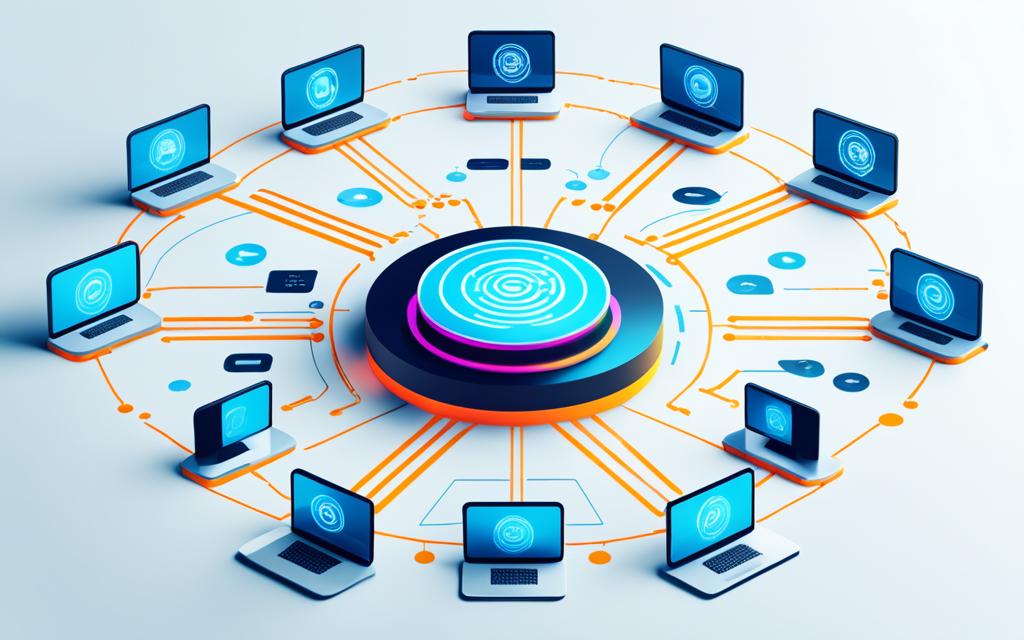Digital identity plays a crucial role in today’s digital world, enabling secure connectivity and streamlining our digital lives. As we navigate the interconnected landscape, managing our digital identities becomes paramount to ensuring secure access to online resources and protecting our personal information.
In computer networks, identity management involves verifying credentials and authorizing transactions. From passwords to more robust authentication methods, the need for secure connectivity grows as the collection of personal data poses risks of impersonation and fraudulent activities.
Enter Personal Area Networks (PAN), which provide a secure and controlled environment for managing digital identities. PANs allow individuals to establish a network of trusted devices that securely hold their digital credentials, ensuring seamless and authenticated access to various online resources.
Whether it’s accessing sensitive corporate information, financial transactions, or personal emails, PANs offer a streamlined approach to digital identity management. By centralizing and protecting our digital identities within personal devices, we can confidently navigate the digital landscape while mitigating the risks associated with data breaches and unauthorized access.
In the upcoming sections, we will explore the intricacies of Identity and Access Management (IAM), the importance of IAM in today’s regulatory climate, various IAM components and technologies, and the choice between cloud and on-premises IAM solutions. By understanding these concepts, you will be equipped with the knowledge to establish a robust digital identity management system that safeguards your online presence.
What is Identity and Access Management (IAM)?
Identity and Access Management (IAM) is a framework that allows businesses to control user access to critical information within their organizations. IAM encompasses various components, including user identification, role assignment, user management, access level assignment, and data protection.
IAM systems use technologies like single sign-on, two-factor authentication, and privileged access management. These systems can be deployed on-premises, in the cloud, or in a hybrid model. IAM provides centralized oversight and visibility into the company’s user base, ensuring that access privileges are granted according to policy and that sensitive data is protected.
With IAM, organizations can efficiently manage user access control, enhancing data governance and security. By implementing a centralized directory service, IAM streamlines user management and access provisioning processes, reducing the risk of unauthorized access and data breaches.
Here is an example of how IAM components can be integrated and interconnected:
| IAM Components | Description |
|---|---|
| User Identification | Unique identification of individual users within the system |
| Role Assignment | Assigning specific roles or job functions to users based on their responsibilities and access requirements |
| User Management | Managing the lifecycle of user accounts, including creation, modification, and deletion |
| Access Level Assignment | Assigning access levels or permissions to users based on their roles and responsibilities |
| Data Protection | Implementing security measures to protect sensitive data from unauthorized access or disclosure |
By incorporating IAM into their infrastructure, organizations can ensure efficient user access control, improved data governance, and enhanced security.
The Importance of IAM
IAM plays a vital role in the protection of corporate resources for organizations facing regulatory and organizational pressures. By implementing IAM solutions, companies can automate user access control and auditing, ensuring granular access control, reducing the risk of data breaches, and improving operational efficiency.
IAM is well-aligned with the transition towards zero-trust models and addresses the security requirements of the Internet of Things (IoT). With advanced technologies like biometrics and behavior analytics, IAM provides robust security measures to safeguard critical assets and sensitive data.
In addition to enhancing security, IAM also helps organizations comply with government regulations by demonstrating effective data protection and providing auditing capabilities. With automated access management, businesses can ensure regulatory compliance, avoiding penalties and reputational damage.
Implementing IAM brings multiple benefits to businesses. By enabling secure collaboration and streamlined access management, IAM fosters efficient workflows and reduces operating costs. Furthermore, IAM empowers organizations to enforce user access control policies consistently and grant access privileges based on authorized roles.
Here is an example of how IAM benefits organizations:
| Benefits of IAM | Explanation |
|---|---|
| Regulatory Compliance | Ensures adherence to government regulations and industry standards, providing data protection and auditing capabilities. |
| User Access Control | Enables granular control over user access privileges based on roles, reducing the risk of unauthorized access. |
| Automated Access Management | Streamlines the process of granting, revoking, and managing user access privileges, improving operational efficiency. |
By investing in effective IAM solutions and embracing the benefits it offers, organizations can gain a competitive advantage in today’s fast-paced digital landscape.

IAM Components and Technologies
IAM systems play a crucial role in ensuring the security of digital identities by offering effective access control mechanisms. One such mechanism is role-based access control, which enables system administrators to regulate access to systems based on individual user roles. By assigning specific roles to users, organizations can ensure that each user has access to the appropriate resources and data.
These IAM systems also handle vital tasks such as capturing user login information, managing user identities, orchestrating access privilege assignments, and providing centralized directory services. This centralized approach simplifies the overall management of user identities and access rights within an organization.
IAM technologies leverage various protocols to enable secure identity management and authentication. Some commonly used protocols include:
- Security Assertion Markup Language (SAML): SAML enables the exchange of authentication and authorization data between identity providers and service providers. It facilitates secure single sign-on across multiple applications and domains.
- OpenID Connect (OIC): OIC is an authentication protocol that builds on top of OAuth 2.0, providing identity information for users. It enables federated identity management and supports single sign-on across different websites and applications.
- Lightweight Directory Access Protocol (LDAP): LDAP is a widely adopted protocol for accessing and maintaining distributed directory information services over a network. It enables organizations to store and organize user identities and access privileges in a hierarchical directory structure.
- OAuth: OAuth is an authorization framework that facilitates delegated access to protected resources, typically using tokens. It allows applications to access user data from other services on behalf of the user.
Another significant aspect of IAM is the integration of advanced authentication methods to enhance security. Biometrics offer a highly secure form of authentication by using unique biological characteristics, such as fingerprints or facial recognition, to verify user identity. This technology adds an additional layer of protection against unauthorized access.
Multi-factor authentication (MFA) further strengthens IAM systems by requiring users to provide multiple forms of identification, such as a password, a one-time passcode sent to a mobile device, or a fingerprint scan. This combination of factors significantly reduces the risk of unauthorized access, offering a more robust security solution.
IAM Components and Technologies Table:
| Component/Technology | Description |
|---|---|
| Role-based Access Control | Regulates access based on user roles, ensuring appropriate access rights. |
| Security Assertion Markup Language (SAML) | Enables secure exchange of authentication and authorization data. |
| OpenID Connect (OIC) | Supports federated identity management and single sign-on across different domains. |
| Lightweight Directory Access Protocol (LDAP) | Provides centralized directory services for user identity and access management. |
| OAuth | Facilitates authorized access to protected resources using tokens. |
| Biometrics | Enhances security by using unique biological characteristics for user authentication. |
| Multi-factor Authentication (MFA) | Requires users to provide multiple forms of identification to authenticate. |
Cloud vs. On-Premises Identity Management
When it comes to managing digital identity, organizations have the option to implement Identity and Access Management (IAM) solutions either on-premises or in the cloud. Each approach offers its own set of advantages, and the choice depends on specific requirements and organizational goals.
Cloud-Based IAM Solutions
Cloud-based IAM solutions have gained popularity due to their numerous benefits. One significant advantage is lower maintenance costs. With cloud IAM, organizations can offload the burden of managing infrastructure, software updates, and security patches to the IAM service provider. This allows businesses to reduce their IT expenses and redirect resources to other critical areas.
Another advantage of cloud IAM is accessibility. Cloud-based solutions offer small businesses the opportunity to access robust IAM capabilities without the need for extensive in-house IT expertise. Additionally, cloud IAM provides access to expert support from the service provider, ensuring organizations receive the necessary assistance in managing their digital identities effectively.
Cloud IAM also offers dedicated security and compliance features. IAM service providers prioritize security and invest in robust infrastructure, encryption, and threat detection mechanisms to protect users’ identities and sensitive data. Compliance with industry regulations is also a key focus, with service providers conducting regular audits and maintaining up-to-date certifications.
Scalability is another noteworthy benefit of cloud IAM. Organizations can easily scale their IAM infrastructure based on their changing needs. Whether they are experiencing rapid growth or need to accommodate seasonal spikes in user activity, cloud IAM allows for seamless scalability without the need for significant hardware investments.
Hybrid IAM Solutions
In some cases, organizations may choose hybrid IAM solutions that combine both on-premises and cloud-based components. Hybrid IAM provides flexibility, allowing organizations to retain control over their identity stores while leveraging cloud-based services.
A common use case for hybrid IAM is when organizations have existing on-premises infrastructure and want to gradually migrate to the cloud. Hybrid IAM enables a phased approach, allowing organizations to transition at their own pace while maintaining control over critical identity management components.
Furthermore, hybrid IAM solutions enable the implementation of advanced features like biometrics and multi-factor authentication without the need for extensive hardware and internal IT infrastructure. Organizations can leverage the cloud’s computing power and scalability to provide secure and convenient authentication methods to their users.
Overall, the decision between cloud and on-premises IAM depends on the organization’s specific requirements, resources, and long-term goals. While cloud IAM offers lower maintenance costs, accessibility, dedicated security and compliance features, and scalability, hybrid IAM provides flexibility and control over identity stores during the transition to the cloud.
Implementing the right IAM solution can significantly enhance an organization’s digital identity management capabilities, ensuring secure connectivity and streamlined operations.
Conclusion
Managing digital identity and ensuring secure connectivity are crucial in today’s ever-evolving technological landscape. As organizations strive to future-proof their Identity and Access Management (IAM) systems, traditional password-based authentication methods are no longer sufficient. Incorporating advanced techniques like biometrics and multi-factor authentication is essential for robust identity verification and access control.
Identity-proofing plays a vital role in enhancing security and preventing credential theft by linking claimed identity with actual identity through document and biometric verification. By implementing zero-trust principles and following the principle of least privilege, organizations can further strengthen their IAM systems and mitigate security risks.
By embracing these advancements in IAM, businesses can protect their digital identities and streamline their digital lives. With passwordless login, identity-proofing measures, and strict adherence to zero-trust principles, organizations can ensure a future-proof IAM framework that provides secure connectivity and optimal data protection.
FAQ
What is digital identity and why is it important?
Digital identity consists of the credentials needed to access online resources. It is crucial for secure and seamless connectivity in today’s digital world. Without a digital identity, it is challenging to verify credentials and authorize transactions. Additionally, digital identity helps ensure trust in access management systems and website credentials, preventing impersonation and fraudulent activities.
What is Identity and Access Management (IAM)?
Identity and Access Management (IAM) is a framework that allows businesses to control user access to critical information within their organizations. It encompasses various components, including user identification, role assignment, user management, access level assignment, and data protection. IAM systems use technologies like single sign-on, two-factor authentication, and privileged access management to ensure secure and regulated access to resources.
Why is IAM important for organizations?
IAM is essential for organizations under regulatory and organizational pressure to protect access to corporate resources. By automating user access control and auditing, IAM enables granular access control, reduces the risk of data breaches, and improves operational efficiency. IAM also aligns with the transition towards zero-trust models and the security requirements of the Internet of Things (IoT). Additionally, IAM helps organizations comply with government regulations by demonstrating data protection and providing auditing capabilities.
What are the key components and technologies of IAM?
IAM systems offer role-based access control, capture user login information, manage user identities, orchestrate access privilege assignments, and provide centralized directory services. IAM technologies include protocols like Security Assertion Markup Language (SAML), OpenID Connect (OIC), Lightweight Directory Access Protocol (LDAP), and OAuth. These technologies support federated identity, single sign-on, and distributed access to connected directories. IAM also incorporates advanced authentication methods, such as biometrics and multi-factor authentication, to enhance security and prevent unauthorized access.
Should IAM be implemented on-premises or in the cloud?
IAM can be implemented on-premises or in the cloud. Cloud-based IAM solutions offer advantages such as lower maintenance costs, accessibility for small businesses, access to expert support, dedicated security and compliance features, and scalability. Cloud IAM allows organizations to offload infrastructure costs and benefit from managed services. Hybrid IAM solutions provide flexibility, allowing organizations to retain control over their identity stores while leveraging cloud-based services. Cloud IAM also enables the implementation of advanced features like biometrics and multi-factor authentication without the need for extensive hardware and internal IT infrastructure.
How can organizations future-proof their IAM strategies?
Future-proofing IAM involves moving beyond traditional password-based authentication and incorporating methods like biometrics and multi-factor authentication. Additionally, identity-proofing, which links claimed identity with actual identity through document verification and biometric verification, enhances security and prevents credential theft. Implementing zero-trust principles and the principle of least privilege can further strengthen IAM and mitigate security risks. By embracing these advancements, organizations can protect their digital identities and streamline their digital lives.



















